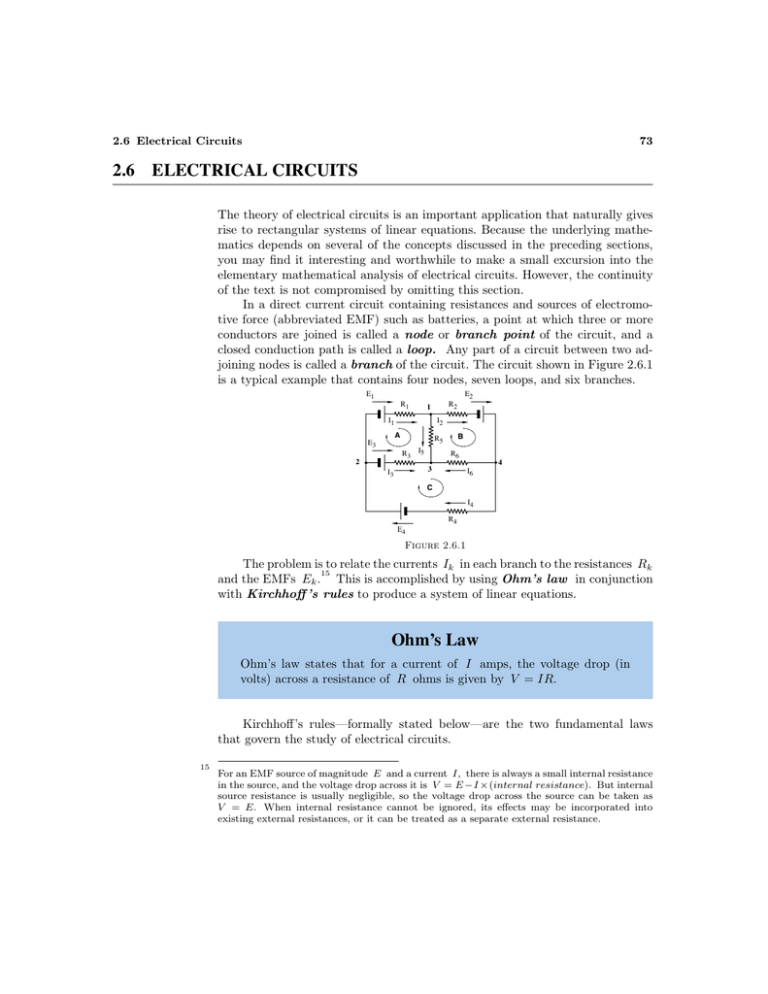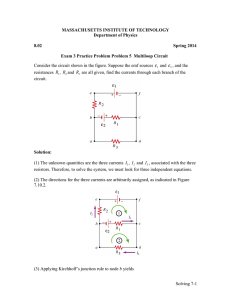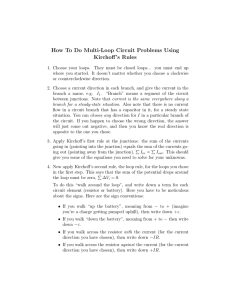2.6 ELECTRICAL CIRCUITS Ohm`s Law
advertisement

2.6 Electrical Circuits 2.6 73 ELECTRICAL CIRCUITS The theory of electrical circuits is an important application that naturally gives rise to rectangular systems of linear equations. Because the underlying mathematics depends on several of the concepts discussed in the preceding sections, you may find it interesting and worthwhile to make a small excursion into the elementary mathematical analysis of electrical circuits. However, the continuity of the text is not compromised by omitting this section. In a direct current circuit containing resistances and sources of electromotive force (abbreviated EMF) such as batteries, a point at which three or more conductors are joined is called a node or branch point of the circuit, and a closed conduction path is called a loop. Any part of a circuit between two adjoining nodes is called a branch of the circuit. The circuit shown in Figure 2.6.1 is a typical example that contains four nodes, seven loops, and six branches. E1 E2 R1 I1 I2 A E3 B R5 R3 2 R2 1 I5 R6 3 I3 4 I6 C I4 R4 E4 Figure 2.6.1 The problem is to relate the currents Ik in each branch to the resistances Rk 15 and the EMFs Ek . This is accomplished by using Ohm’s law in conjunction with Kirchhoff ’s rules to produce a system of linear equations. Ohm’s Law Ohm’s law states that for a current of I amps, the voltage drop (in volts) across a resistance of R ohms is given by V = IR. Kirchhoff’s rules—formally stated below—are the two fundamental laws that govern the study of electrical circuits. 15 For an EMF source of magnitude E and a current I, there is always a small internal resistance in the source, and the voltage drop across it is V = E −I ×(internal resistance). But internal source resistance is usually negligible, so the voltage drop across the source can be taken as V = E. When internal resistance cannot be ignored, its effects may be incorporated into existing external resistances, or it can be treated as a separate external resistance. 74 Chapter 2 Rectangular Systems and Echelon Forms Kirchhoff’s Rules NODE RULE: The algebraic sum of currents toward each node is zero. That is, the total incoming current must equal the total outgoing current. This is simply a statement of conservation of charge. LOOP RULE: The algebraic sum of the EMFs around each loop must equal the algebraic sum of the IR products in the same loop. That is, assuming internal source resistances have been accounted for, the algebraic sum of the voltage drops over the sources equals the algebraic sum of the voltage drops over the resistances in each loop. This is a statement of conservation of energy. Kirchhoff’s rules may be used without knowing the directions of the currents and EMFs in advance. You may arbitrarily assign directions. If negative values emerge in the final solution, then the actual direction is opposite to that assumed. To apply the node rule, consider a current to be positive if its direction is toward the node—otherwise, consider the current to be negative. It should be clear that the node rule will always generate a homogeneous system. For example, applying the node rule to the circuit in Figure 2.6.1 yields four homogeneous equations in six unknowns—the unknowns are the Ik ’s: Node 1: I1 − I2 − I5 = 0, Node 2: − I1 − I3 + I4 = 0, Node 3: I3 + I5 + I6 = 0, Node 4: I2 − I4 − I6 = 0. To apply the loop rule, some direction (clockwise or counterclockwise) must be chosen as the positive direction, and all EMFs and currents in that direction are considered positive and those in the opposite direction are negative. It is possible for a current to be considered positive for the node rule but considered negative when it is used in the loop rule. If the positive direction is considered to be clockwise in each case, then applying the loop rule to the three indicated loops A, B, and C in the circuit shown in Figure 2.6.1 produces the three nonhomogeneous equations in six unknowns—the Ik ’s are treated as the unknowns, while the Rk ’s and Ek ’s are assumed to be known. Loop A: I1 R1 − I3 R3 + I5 R5 = E1 − E3 , Loop B: I2 R2 − I5 R5 + I6 R6 = E2 , Loop C: I3 R3 + I4 R4 − I6 R6 = E3 + E4 . 2.6 Electrical Circuits 75 There are 4 additional loops that also produce loop equations thereby making a total of 11 equations (4 nodal equations and 7 loop equations) in 6 unknowns. Although this appears to be a rather general 11 × 6 system of equations, it really is not. If the circuit is in a state of equilibrium, then the physics of the situation dictates that for each set of EMFs Ek , the corresponding currents Ik must be uniquely determined. In other words, physics guarantees that the 11 × 6 system produced by applying the two Kirchhoff rules must be consistent and possess a unique solution. Suppose that [A|b] represents the augmented matrix for the 11 × 6 system generated by Kirchhoff’s rules. From the results in §2.5, we know that the system has a unique solution if and only if rank (A) = number of unknowns = 6. Furthermore, it was demonstrated in §2.3 that the system is consistent if and only if rank[A|b] = rank (A). Combining these two facts allows us to conclude that rank[A|b] = 6 so that when [A|b] is reduced to E[A|b] , there will be exactly 6 nonzero rows and 5 zero rows. Therefore, 5 of the original 11 equations are redundant in the sense that they can be “zeroed out” by forming combinations of some particular set of 6 “independent” equations. It is desirable to know beforehand which of the 11 equations will be redundant and which can act as the “independent” set. Notice that in using the node rule, the equation corresponding to node 4 is simply the negative sum of the equations for nodes 1, 2, and 3, and that the first three equations are independent in the sense that no one of the three can be written as a combination of any other two. This situation is typical. For a general circuit with n nodes, it can be demonstrated that the equations for the first n − 1 nodes are independent, and the equation for the last node is redundant. The loop rule also can generate redundant equations. Only simple loops— loops not containing smaller loops—give rise to independent equations. For example, consider the loop consisting of the three exterior branches in the circuit shown in Figure 2.6.1. Applying the loop rule to this large loop will produce no new information because the large loop can be constructed by “adding” the three simple loops A, B, and C contained within. The equation associated with the large outside loop is I1 R1 + I2 R2 + I4 R4 = E1 + E2 + E4 , which is precisely the sum of the equations that correspond to the three component loops A, B, and C. This phenomenon will hold in general so that only the simple loops need to be considered when using the loop rule. 76 Chapter 2 Rectangular Systems and Echelon Forms The point of this discussion is to conclude that the more general 11 × 6 rectangular system can be replaced by an equivalent 6 × 6 square system that has a unique solution by dropping the last nodal equation and using only the simple loop equations. This is characteristic of practical work in general. The physics of a problem together with natural constraints can usually be employed to replace a general rectangular system with one that is square and possesses a unique solution. One of the goals in our study is to understand more clearly the notion of “independence” that emerged in this application. So far, independence has been an intuitive idea, but this example helps make it clear that independence is a fundamentally important concept that deserves to be nailed down more firmly. This is done in §4.3, and the general theory for obtaining independent equations from electrical circuits is developed in Examples 4.4.6 and 4.4.7. Exercises for section 2.6 2.6.1. Suppose that Ri = i ohms and Ei = i volts in the circuit shown in Figure 2.6.1. (a) Determine the six indicated currents. (b) Select node number 1 to use as a reference point and fix its potential to be 0 volts. With respect to this reference, calculate the potentials at the other three nodes. Check your answer by verifying the loop rule for each loop in the circuit. 2.6.2. Determine the three currents indicated in the following circuit. 5Ω 8Ω I2 I1 12 volts 1Ω 1Ω 9 volts 10Ω I3 2.6.3. Determine the two unknown EMFs in the following circuit. 20 volts 6Ω 1 amp 4Ω E1 2 amps E2 2Ω 2.6 Electrical Circuits 77 2.6.4. Consider the circuit shown below and answer the following questions. R2 R3 R5 R1 R4 R6 I E (a) How many nodes does the circuit contain? (b) How many branches does the circuit contain? (c) Determine the total number of loops and then determine the number of simple loops. (d) Demonstrate that the simple loop equations form an “independent” system of equations in the sense that there are no redundant equations. (e) Verify that any three of the nodal equations constitute an “independent” system of equations. (f) Verify that the loop equation associated with the loop containing R1 , R2 , R3 , and R4 can be expressed as the sum of the two equations associated with the two simple loops contained in the larger loop. (g) Determine the indicated current I if R1 = R2 = R3 = R4 = 1 ohm, R5 = R6 = 5 ohms, and E = 5 volts.


